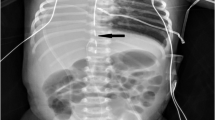Abstract
The diagnosis of oesophageal atresia (OA) is usually made soon after birth. Two diagnostic criteria are failure to pass a nasogastric (NG) tube and a chest radiograph demonstrating a curled NG tube in the upper oesophageal pouch. A 6-day-old neonate was referred to our institution with persistence of symptoms following exclusion of the diagnosis of OA on the basis of an NG tube radiologically confirmed to reach the stomach. Persistent oxygen desaturations and copious salivation led to further investigations, and a delayed diagnosis of oesophageal atresia and tracheo-oesophageal fistula was made. Radiological demonstration of an NG tube reaching the stomach does not exclude the diagnosis of oesophageal atresia and can be falsely reassuring and lead to diagnostic delay.





Similar content being viewed by others
References
Houben CH, Curry JI (2008) Current status of prenatal diagnosis, operative management and outcome of esophageal atresia/tracheo-esophageal fistula. Prenat Diagn 28:667–675
Sparey C, Jawaheer G, Barrett AM et al (2000) Esophageal atresia in the Northern Region Congenital Anomaly Survey, 1985–1997: prenatal diagnosis and outcome. Am J Obstet Gynecol 182:427–431
Author information
Authors and Affiliations
Corresponding author
Rights and permissions
About this article
Cite this article
Kuti, K., Patel, R., Chapman, S. et al. A rare pitfall in the diagnosis of oesophageal atresia. Pediatr Radiol 43, 902–904 (2013). https://doi.org/10.1007/s00247-010-1685-8
Received:
Accepted:
Published:
Issue Date:
DOI: https://doi.org/10.1007/s00247-010-1685-8




